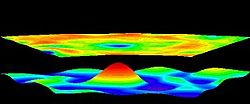Mare Serenitatis
| Mare Serenitatis | ||
|---|---|---|
 | ||
| Mare Serenitatis | ||
| Position | 27,29° N, 18,36° O | |
| Durchmesser | 674 km | |
| Siehe auch Gazetteer of Planetary Nomenclature | ||


Das Mare Serenitatis (lat. „Meer der Heiterkeit“) ist ein Mondmeer östlich des Mare Imbrium auf dem Erdmond. Es befindet sich im Serenitatis-Becken.
Das Mare Serenitatis grenzt an das Mare Tranquillitatis im Südosten sowie an das Mare Vaporum im Südwesten.
Entlang des südwestlichen Beckenrandes zieht sich das Gebirge Montes Haemus. Weiter westlich vom Mare landete Apollo 15. Südöstlich seines Randes liegen die Montes Taurus, in deren Nähe Luna 21 und Apollo 17 landeten.
Das Meer liegt mittig auf den selenografischen Koordinaten 28° 00′ N, 17° 30′ E. Der mittlere Durchmesser beträgt 707 km.
Kulturelles
Das Mare Serenitatis wird volkstümlich auch als ein Auge des Mannes im Mond angesehen.
Im Roman Heliopolis von Ernst Jünger wird anfangs eine Begehung des Mare erwähnt und damit die Handlung als in der Zukunft spielend gekennzeichnet.
In der Anime-Serie Sailor Moon ist das Mare Serenitatis der Ort, an dem sich früher das Mondkönigreich befand.
Weblinks
- Lunar.arc.nasa.gov: Mare Serenitatis (englisch)
- Mare Serenitatis im The Moon-Wiki (englisch)
- Spektrum.de: Amateuraufnahmen: [1][2][3]
Auf dieser Seite verwendete Medien
NASA lunar chart of equatorial region (latitudes 45S to 45N) 1 : 10.000.000 (LPC-1).
Mare Serenitatis sits just to the east of Mare Imbrium. It is located within the Serenitatis basin, which is of the Nectarian epoch. The material surrounding the mare is of the Lower Imbrian epoch, while the mare material is of the Upper Imbrian epoch. The mare basalt covers a majority of the basin and overflows into Lacus Somniorum to the northeast. The most noticeable feature is the crater Posidonius on the northeast rim of the mare. The ring feature to the west of the mare is indistinct, except for Montes Haemus. Mare Serenitatis connects with Mare Tranquillitatis to the southeast.




